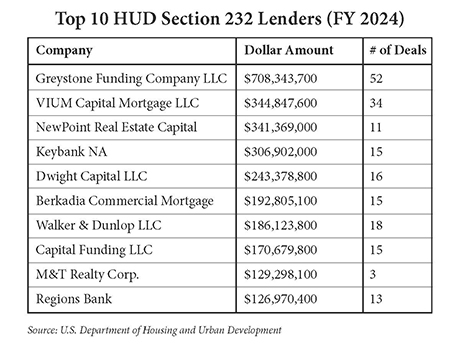The consensus among lenders in the U.S. Department of Housing and Urban Development’s LEAN healthcare mortgage insurance program is that loan volume in fiscal year (FY) 2025 will surpass the prior year’s total of $3.1 billion due to a combination of factors. The lending program, which stems from Section 232 of the National Housing Act, plays a vital role in helping finance nursing homes and assisted living facilities. HUD LEAN is a streamlined program for processing Section 232 applications.
“Lending volume should only rise in 2025,” predicts Sampada D’silva, chief credit officer, HUD healthcare lending, at Greystone. “Despite the initial setbacks caused by the pandemic, the industry has demonstrated significant recovery. This rebound has not only stabilized operations, but it also has positioned facilities to qualify for HUD programs,” she explains.

“Also, the industry has experienced a record volume of M&A activity, further driving the demand for HUD takeouts of acquisition bridge loans. HUD’s long-term, fixed-rate and higher loan-to-value program is typically the end goal for the borrowers in the industry,” adds D’silva.
Greystone ranked as the top lender in the HUD LEAN program in FY 2024 with 52 transactions totaling $708.3 million. It was the fifth consecutive year that Greystone ranked No. 1. (HUD’s fiscal year runs from Oct. 1 to Sept. 30.)
Steve Kennedy, executive managing director of VIUM Capital, expects loan volume in FY 2025 will exceed the prior year’s total for two reasons: improved operating fundamentals of the asset class and “a glut” of loan maturities.
“As long as the 10-year Treasury yield remains below 5 percent, we would expect the HUD 232 program to have more volume than FY 2024. However, staffing constraints at HUD will cause the HUD 232 queue (currently at about four months) to grow, thereby limiting overall HUD production,” says Kennedy.
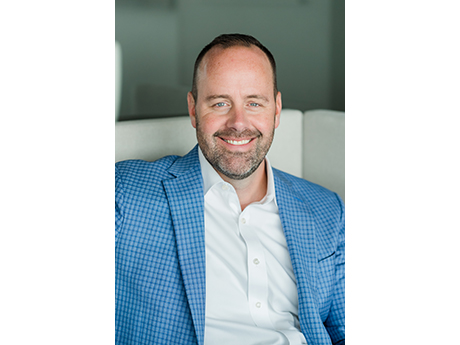
VIUM closed 34 loans totaling nearly $345 million in FY 2024, making it the second largest lender in the HUD LEAN program.
D’silva says the HUD staff is taking significant steps to accelerate transaction processing, including hiring additional personnel and contractors to manage the growing pipeline.
Breindy Sochet, director of healthcare real estate at NewPoint Real Estate Capital, points to empirical evidence that loan production is on the rise, which bodes well for deal volume in FY 2025.
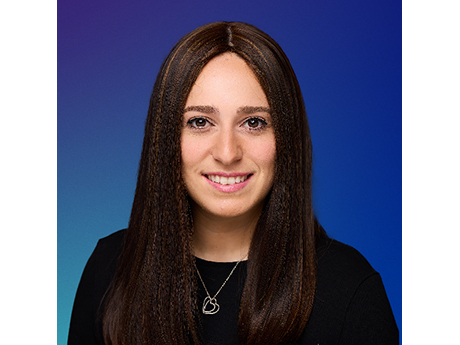
NewPoint Real Estate Capital
“HUD issued just over $4.09 billion in firm commitments in FY 2024. However, if you annualize commitments issued in the first and second quarters of FY 2024 versus the third and fourth quarters, you get $3.47 billion versus $4.71 billion,” notes Sochet.
“Assuming the same level of commitments persists into 2025 — and with the HUD queue currently at over 100 loans — lending volume in FY 2025 will definitely exceed FY 2024.”
NewPoint closed 11 loans totaling $341.4 million in FY 2024, good enough for third place on the list of top HUD LEAN lenders.
Tim Eberhardt, chief lending officer for bridge and HUD loans at CFG Bank (CFG), is optimistic about deal volume for a few different reasons. “Looking at the industry from a 30,000-foot level, our expectation is for lending volume to increase as facilities stabilize with more beneficial reimbursement rates and HUD’s increase in corporate credit capacity.”
To his point, the Centers for Medicare & Medicaid Services increased the Medicare reimbursement to nursing homes by 4.2 percent, or $1.4 billion, for FY 2025.
Regarding the corporate credit capacity issue, HUD previously required owners and operators of residential care portfolios with an aggregate unpaid mortgage amount of $90 million or greater to undergo a portfolio corporate credit review (CCR) before applying for any additional loans. In April 2024, HUD raised the threshold to $193.8 million. That’s significant because a CCR takes 90 days or more to complete, which adds additional time to the HUD financing process.
Capital Funding Group (CFG) closed 15 loans totaling $170.7 million in FY 2024, earning the No. 8 spot on the list of the top 10 lenders in the HUD LEAN program.
“CFG expects its lending volume in FY 2025 to exceed last year’s total as deals continue to season and stabilize and borrowers look to exit [short-term financing] with 30-year, nonrecourse financing at competitive rates,” says Eberhardt.
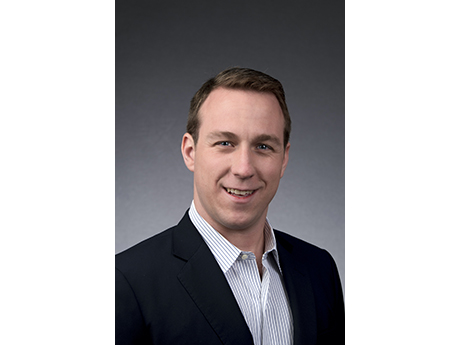
CFG Bank
Jason Smeck, a director at Lument specializing in seniors housing and healthcare production, cites two factors for the expected uptick in business. “We are seeing better industry financial performance and increased interest in the program.”
Lument closed six loans totaling $85 million through the mortgage insurance program in FY 2024. “We are positioned to significantly exceed this production level in FY 2025, and our future pipeline continues to build,” says Smeck.
Deal Trends
In FY 2024, there was a 25 percent year-over-year increase in the number of HUD 232/223(f) loans, which offer nonrecourse, fixed-rate, long-term financing for the acquisition or refinancing of existing senior living and healthcare facilities. What caused the number of 223(f) loans to increase from 175 in FY 2023 to 219 in FY 2024?
“Deals financed as bridge acquisition loans during the pandemic have finally stabilized to levels that support a HUD exit,” says Eberhardt. “Contributing factors include, but are not limited to, increases in state reimbursements and operators decreasing their reliance on agency staffing.”
Sochet says the slow and steady recovery of the seniors housing industry in the wake of the COVID-19 pandemic is driving the increase in the number of 223(f) loans.
“Oftentimes, borrowers are purchasing assets that are distressed, either due to COVID-19 or other reasons. Once they successfully execute a turnaround strategy, they can become eligible for a HUD 223(f) refinance. We expect HUD’s 223(f) production will continue to increase as we see additional market recovery,” says Sochet.
There wasn’t a single 232/223(a)(7) loan closing for a healthcare property in FY 2024 compared with 20 in FY 2023. The HUD 223(a)(7) loan is designed for refinancing existing debt on healthcare properties backed by HUD. By refinancing through a 223(a)(7) loan, borrowers can lower interest rates, extend amortization and improve property cash flows while reducing debt-service costs.
“The 223(a)(7) program is interest-rate sensitive. Hence, in FY 2024 when rates continued to increase compared to FY 2023, there were no more savings to reap for the borrowers,” D’silva points out.
Construction Financing in Hibernation?
In the category of “New Construction & Other,” there was only a single $12.6 million loan that closed in FY 2024. The results were similar in FY 2023 and FY 2022. The category includes the Section 232 new construction program and the 232/241(a) program that provides supplemental financing for the construction of additions to healthcare facilities.
“While such projects can be financed through HUD’s 232 program, the process is relatively long and introduces some complexities, including Davis-Bacon prevailing wages. The HUD 232 program is generally designed as a permanent refinance program rather than a new construction loan program,” says Kennedy.
(The Davis-Bacon Act requires contractors or their subcontractors to pay workers employed directly upon on the worksite no less than the locally prevailing wages and fringe benefits paid on projects of a similar character.)
There are a few factors that have led to the lack of construction financing secured through HUD in the seniors housing space, explains Smeck.
“HUD’s focus during and after the pandemic has clearly been on providing permanent financing for existing stabilized projects. Occupancy in skilled nursing and senior living communities dropped dramatically at the beginning of the COVID pandemic. We are only now, four years later, reaching occupancy levels similar to pre-pandemic timeframes,” explains Smeck.
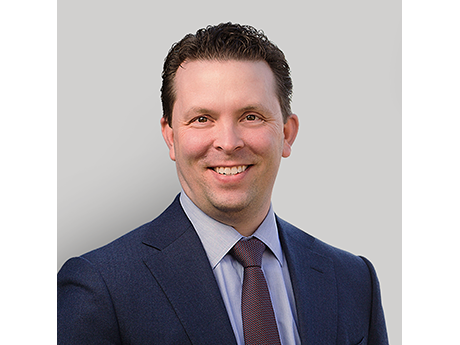
Meanwhile, construction starts for senior living throughout the country have dwindled, he adds. During the pandemic, investors shifted their focus to the purchase of existing assets at pricing levels below the cost of new construction.
HUD has indicated that it is cautiously considering new construction applications at this time, but will only seriously consider applications for owners with very substantial experience in the development, lease-up and operation of similar seniors housing communities, according to Smeck. Within the new construction category, HUD is most interested in the 232/241(a)
program, which provides construction financing to expand existing stabilized and financially successful operations.
Interest Rate Swings Have Impact
The Federal Reserve has cut the benchmark federal funds rate three times since Sept. 18, 2024, for a total of 100 basis points. As of Jan. 23, the federal funds target rate range was 4.25 to 4.5 percent. During the same period, however, the yield on the 10-year U.S. Treasury bond increased from 3.8 percent to 4.6 percent. In short, these two benchmark rates have been moving in opposite directions.
Long-term, fixed-rate loans that are originated through the HUD LEAN program are priced off the 10-year Treasury yield, so that approximate increase of 80 basis points in a short period of time has many borrowers concerned.
“Just when you think rates are on the right downward path, a spike in the 10-year U.S. Treasury yield dampens the enthusiasm of lenders and borrowers,” says Smeck.
Eberhardt notes that as the Federal Reserve began cutting rates prior to the Nov. 5 presidential election, borrowers and lenders were able to see and feel the divergence between the short and long-term side of the overall yield curve, which he believes further proves that the two won’t always be correlated.
“While short-term yields were falling in consonance with adjustments to the overnight lending rate, yields at the long end of the curve were pushed higher by investors looking to the economic numbers, particularly the U.S. Labor Department figures, which signaled a rather robust market with still a fight to go on the inflationary front.”
When the election campaign began heating up, the market began pricing in a greater chance that Donald Trump would prevail over Kamala Harris, says Eberhardt. “The fear was that between all the tariffs, tax cuts and deficit spending that are part of the Trump plan, inflation would work its way back into the picture, sending yields sharply higher with the 10-year reaching 4.8 percent again at one point.”
State of the Industry
The seniors housing occupancy rate across the 31 primary markets tracked by NIC MAP rose from 86.5 percent in the third quarter of 2024 to 87.2 percent in the fourth quarter, surpassing pre-pandemic occupancy levels. (The figures are for independent living and assisted living combined.)
There were fewer than 22,000 senior living units under construction in the fourth quarter, the lowest level since the first quarter of 2014. For all of 2024, developers added just under 8,800 units of inventory, below the historical average. Given the current supply and demand trends, NIC is forecasting occupancy to surpass 90 percent by the end of 2026.
While operating expenses and capital market challenges remain a concern, Eberhardt says the outlook for the seniors housing sector is positive, given the strong demand and limited inventory growth due to relatively high interest rates and construction costs. Consequently, the focus has shifted from new construction to mergers and acquisitions, with M&A activity steadily increasing since 2023, he observes.
“Well-capitalized investors have successfully navigated opportunities presented by discounted acquisitions, positioning themselves to benefit from the sector’s strong demand,” notes Eberhardt. “Looking ahead, sustained demand, interest rate cuts and market opportunities are expected to further drive M&A growth in 2025.”
The limited new supply and continued growth in demand have led to a gradual recovery in the performance of seniors housing, with increased margins set to follow, according to Kennedy. “Long-term demand for the asset class remains strong, including an exponential need for more affordable seniors housing.”
Smeck’s assessment is that the seniors housing sector is in the latter stages of recovery, but that it is also at a crossroads.
“Occupancy has been on a steady upswing for the past three years, there has been essentially no new development since the pandemic, and the baby boomer generation is approaching ages at which senior living becomes more necessary. At the same time, the industry continues to face challenges with increased operational complexity, vast levels of regulation in the skilled nursing industry and continued difficulties with recruiting and retaining qualified staff,” says Smeck.
The inventory growth of seniors housing has slowed due to construction challenges, acknowledges Sochet. Meanwhile, the 80-plus population is growing and projected to increase sharply over the next two decades. With demand outpacing supply, the likely result is occupancy and rent growth.
“We’re feeling optimistic about the sector. However, these stats are market specific and should be relied upon with caution,” says Sochet. “There are many individual markets — due to either oversaturation, demographics, migration trends and/or persistent staffing challenges — that are still struggling.”
— Matt Valley

